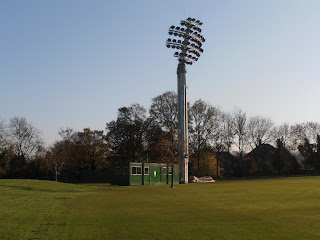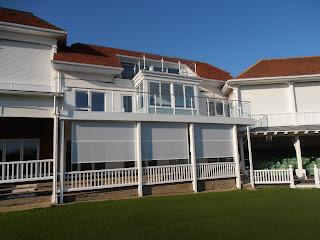This time, I was looking forward, not
back. My purpose was to inspect the redevelopment, which, after some
delay, has got under way in the 18 months since I was last here. We
are promised that it is Kent's financial salvation, but at what other
cost? On a glorious November afternoon, quite nice enough for there
to be play, I went to find out.
Continuity is what I was looking for.
That it would remain recognisably the same ground as that on which I
first watched cricket on in the sixties, or that on which Les Ames
and Frank Woolley batted and Tich Freeman bowled, come to that. It is
pleasing to report that, so far at least, impressions are favourable.
The old practice area, an attractive
part of the ground backed by a converted oast house, has disappeared
under housing. Alec Stewart will be pleased. In a recent edition of
The Cricketer, he blamed the St Lawrence practice pitches for
England's early exit from the 1999 World Cup. It was not clear where
they have been relocated. Nor did I work out how the new owners get
to and from their homes. Will they have to pay admission on
matchdays?
There is more building going on off the
main driveway, consisting of a new administration block and other
facilities including, it was announced this week, a small
Sainsbury's. This is very good, though they had better lay in extra
supplies of Scotch eggs next time I'm there. Every ground should have
a supermarket close by. Folkestone had one right outside, one of the
reasons why it was such a great place to watch cricket. Here in New
Zealand, Seddon Park in Hamilton has a shopping centre just across
the road. I once had a haircut and a sit-down lunch and was still
back in my seat by the time the first ball of the afternoon session
was bowled. More building, including a hotel on the Old Dover Road
side of the ground, is to follow.
Five floodlight towers have been
installed (all telescopic so as not offend to the sensibilities of
the residents in this well-heeled part of town): next to the Leslie
Ames Stand, beside the indoor school, next to the Frank Woolley
Stand, behind where the white scoreboard used to be and near the site
of the old lime tree. I disapprove of course, but not on aesthetic
grounds. Floodlights, lit or not, add a certain grandeur to sports
grounds. It is simply that conditions in England are not suited to
floodlit cricket. I have long thought that English cricket should
make more use of long summer evenings with matches in June and July
starting later and finishing at 8 or 8.30 pm. It would be perfectly
possible to begin T20 games at 6 pm, or even 6.30 pm in the north.
Outside the height of summer, conditions are rarely conducive to
after-dark viewing, spectacular though it can be.
The good news is this: far from being
ruined as some of us feared, the stands that define the playing arena
have been entrenched and enhanced. I worried that they might do away
with the wooden stand, or pavilion annexe as it was officially known.
But it has been given a proper name at last, and what a good one: the
Underwood and Knott Stand. The very place from which I used to watch
the two great heroes of my youth now named after them. Splendid.
Best of all, the regretable
late-sixties brick dressing rooms have been extended and transformed
so as to fit in perfectly with the wooden, red-tiled buildings on
either side. They look as though they might have been there since
1906, when the Underwood and Knott Stand was built.
The shop was open and I was
sufficiently relieved and impressed by what I had seen to buy a club
polo shirt, so the white horse will be seen at the Basin this summer.
The redevelopment seems to be having the desired financial benefits
too; the club has just announced a six-figure profit for the past
year. Too late to keep Joe Denly on the premises, but a sign that
things will soon be on the up, we hope.








